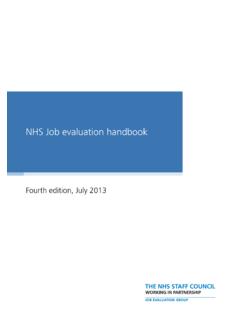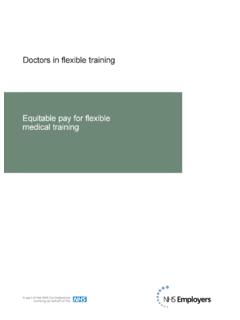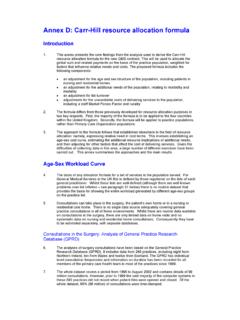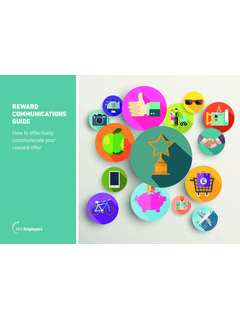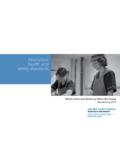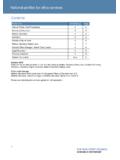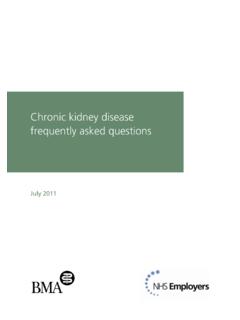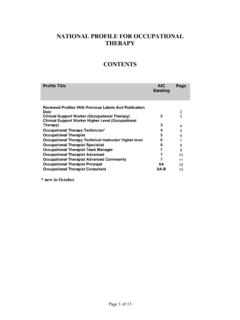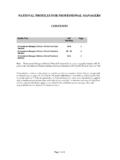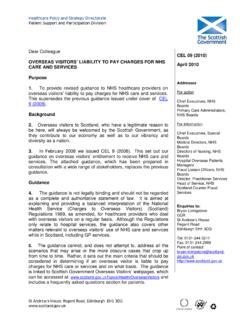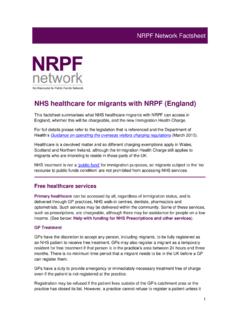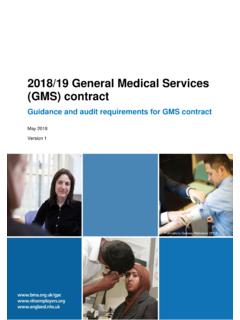Transcription of 2017/18 General Medical Services (GMS) contract
1 1 2017 /18 General Medical Services (GMS) contract guidance for GMS contract 2017 /18 August 2017 Gateway Reference 07304 2 Contents Section 1 Introduction 3 Section 2 New contractual requirements from 2017 /18 4 Data collection for indicators no longer in QOF and enhanced Services 4 National diabetes audit 4 Workforce data collection 5 Identification and management of patients with frailty 6 Access to healthcare change to registration process for overseas visitors accessing healthcare 8 Registration of people released from prisons, immigration centres or children s secure facilities 9 Section 3 Queries process 12 Section 4 Annexes 14 3 Section 1: Introduction In February 2017 , NHS Employers (on behalf of NHS England) and the British Medical Association s (BMA) General Practitioners Committee England (GPC) agreed changes to the General Medical Services (GMS) contract for 2017 /18.
2 This guidance provides information about the new contractual requirements. Participating commissioners and practices should ensure they have read and understood the requirements in the Regulations, Directed Enhanced Services (DES) Directions and NHS England service specifications, the guidance in this document as well as the Technical requirements for 2017 /18 GMS contract changes 1. This supersedes all previous guidance on these areas. Wherever possible, NHS England seeks to minimise the reporting requirements for the Services delivered by practices where these can be supported by new systems and this guidance outlines the audit requirements for the Services detailed.
3 Separate technical requirements document detailing the Read codes which practices are required to use are detailed in the Technical requirements document . This guidance is applicable in England only. The amendments to the GMS contract Regulations, DES Directions and to the Statement of Financial Entitlements (SFE), which underpin the changes to the contract , are available on the Department of Health (DH)2 and NHS Employers website3. The detailed requirements for taking part in the enhanced Services (ESs) are set out in the DES Directions or service specifications. 1 NHS Employers.
4 Technical requirements for 2017 /18 GMS contract changes. 2 Legal documents underpinning GMS contract changes. 3 NHS Employers. Technical requirements document for 2017 /18 GMS contract changes. 4 Section 2: New contractual arrangements for 2017 /18 Data collection for indicators no longer in QOF and enhanced Services In relation to those indicators no longer in QOF (INLIQ) and retired enhanced Services (ES), GPs will continue to use their professional judgement and continue to treat patients in accordance with best clinical practice guidelines. From 1 October 2017 , it will be a contractual requirement for practices to facilitate data collection on a selection of INLIQ indicators and ES s.
5 Practices will continue to undertake relevant clinical work and code activity as clinically appropriate in relation to these indicators and ESs. A list of the data to be collected for 2017 /18 is in Annex A. Periodically, NHS England will collect anonymised data from practices clinical systems (in relation to ES and INLIQ) which will provide statistical information, be processed for audit and publication and will help inform commissioners and practices. It is not intended for performance management purposes. National Diabetes Audit (NDA) The NDA is one of the largest and most comprehensive clinical audits in the world.
6 It integrates data from both primary and secondary care sources. Using this data it aims to help improve diabetes care by enabling NHS Services and organisations to: identify and share best practice identify gaps or shortfalls that are priorities for improvement assess local practice against NICE guidelines compare their care and care outcomes with similar Services and organisations provide comprehensive national pictures of diabetes care and outcomes in England and Wales. The NDA is commissioned by the Healthcare Quality Improvement Partnership (HQIP) as part of the National Clinical Audit Programme (NCA) and delivered by the NHS Digital in partnership with Diabetes UK and the National Cardiovascular Intelligence Network (part of Public Health England (PHE)).
7 The NDA receives expert input from clinicians and people with diabetes across England and Wales. Practice involvement in the audit is important to ensure that local Services are able to benchmark their activity and review the quality of treatment and care across an area. The audit is designed to answer four questions: 5 Is everyone with diabetes diagnosed and recorded on a practice diabetes register? What percentage of people registered with diabetes received the nine NICE key processes of diabetes care? What percentage of people registered with diabetes achieved NICE defined treatment targets for glucose control, blood pressure and blood cholesterol?
8 For people with registered diabetes what are the rates of acute and long-term complications (disease outcomes)? From October 2017 , practices will be contractually required to allow collection of data relating to the NDA. Practices should be aware of their duties and responsibilities under the fair processing guidelines4 and a patient s right to opt-out of data collections containing confidential personal information. Practices will be required to code activity relating to the NDA as appropriate and allow data to be collected from their clinical systems. This data will then be fed automatically in to the wider NDA reporting process.
9 Facilitating these automated collections will reduce practice workload associated with this clinical audit. Further detail on the Read codes, management information counts and frequency collection will be available in the Technical requirements document 5 as soon as this information is available. Further information about the audit is available on the NHS Digital website6. Workforce data collection The NHS Digital General Practice Workforce Minimum Data Set is the successor to the General Practice Workforce Census. It is a practice level collection provided through the Primary Care Web Tool and Health Education England data tools, to give the detailed view of the General Practice workforce.
10 It includes data on doctors (data published quarterly by NHS Digital) plus other practice staff (published bi-annually). The outputs of the data collection are important to help shape policy and investment around the workforce. More recently, this data is vital to support monitoring the delivery of the commitment to an additional 5,000 doctors plus 5,000 other staff commitments made in the GP Forward View by 2020/21. Approximately 93 per cent of practices submit data through these collection tools. In order to ensure a robust data set can be collected, it is necessary to increase the returns to 100 per cent.
